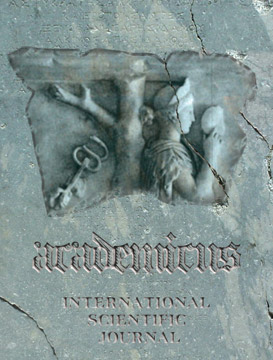Title:
How Do the Richest 1% Owns 50% of Wealth in a Small-Open Growth Model with Endogenous Wealth and Human Capital
Full Reference List:
| 1. | Arrow, K.J. (1962) The Economic Implications of Learning by Doing. Review of Economic Studies 29, 155-73. |
| 2. | Arrow, K. J. (1974) General Economic Equilibrium: Purpose, Analytic Techniques, Collective Choice. American Economic Review 64, 253-72. |
| 3. | Arrow K.J. and Debreu, G. (1954) Existence of an Equilibrium for a Competitive Economy. Econometrica 22, 265–90. |
| 4. | Arrow, K.J. and Hahn, F.H. (1971) General Competitive Analysis. San Francisco: Holden-Day, Inc. |
| 5. | Azariadis, C. (1993) Intertemporal Macroeconomics. Oxford: Blackwell. |
| 6. | Barro, R.J. and X. Sala-i-Martin (1995) Economic Growth. New York: McGrawHill, Inc. |
| 7. | Benabou, R. (2002) Tax and Education Policy in a Heterogeneous-Agent Economy: What levels of Redistrbution Maximize Growth and Efficiency? Econometrica 70, 481-517. |
| 8. | Benigno, G. and Benigno, P. (2003) Price Stability in Open Economies. Review of Economic Studies 70, 743-64. |
| 9. | Bourguignon, F. (1981) Parento-superiority of Unegalitarian Equilibria in Stiglitz’s Model of Wealth Distribution with Convex Saving Function. Econometrica 49, 1469-75. |
| 10. | Burmeister, E. and Dobell, A.R. (1970) Mathematical Theories of Economic Growth. London: Collier Macmillan Publishers. |
| 11. | Debreu, G. (1959) Theory of Value: An Axiomatic Analysis of Equilibrium. Yale University Press, London. |
| 12. | Forbes, K. (2000) A Reassessment of the Relationship Between Inequality and Growth. American Economic Review 90, 869-70. |
| 13. | Frank, M.W. (2009) Inequality and Growth in the United States: Evidence from a New State-level Panel of Income Inequality Measures. Economic Inquiry 47, 55-68. |
| 14. | Gale, D. (1955) The Law of Supply and Demand. Mathematica Scandinavica 3, 33–44 |
| 15. | Gali, J. and Monacelli, T. (2005) Monetary Policy and Exchange Rate Volatility in a Small Open Economy. Review of Economic Studies 72, 707-34. |
| 16. | Galor, O. and Moav, O. (2004) From Physical to Human Capital Accumulation: Inequality in the Process of Development. Review of Economic Studies 71, 1001-26. |
| 17. | Galor, O. and Zeira, J. (1993) Income Distribution and Macroeconomics. Review of Economic Studies 60, 35-52. |
| 18. | Ilzetzkia, E., Mendozab, E.G., and Véghc, G.A. (2013) How Big (Small?) Are Fiscal Multipliers? Journal of Monetary Economics 60 (2), pp. 239–54. |
| 19. | Kaldor, N. (1956) Alternative Theories of Distribution. Review of Economic Studies 23, 83–100. |
| 20. | Kollmann, R. (2001) The Exchange Rate in a Dynamic-Optimizing Business Cycle Model with Nominal Rigidities: A Quantitative Investigation. Journal of International Economics 55, 243-62. |
| 21. | Kollmann, R. (2002) Monetary Policy Rules in the Open Economy: Effects on Welfare and Business Cycles. Journal of Monetary Economics 49, 899-1015. |
| 22. | Lane, P.R. (2001) The New Open Economy Macroeconomics: A Survey. Journal of International Economics 54, 235-66. |
| 23. | Mas-Colell, A., Whinston, M.D. and Green, J.R. (1995) Microeconomic Theory. New York: Oxford University Press. |
| 24. | McKenzie, L.W. (1959) On the Existence of General Equilibrium for a Competitive Market. Econometrica 27, 54–71. |
| 25. | Nikaido, H. (1956) On the Classical Multilateral Exchange Problem. Metroeconomica 8, 135–45. |
| 26. | Nikaido, H. (1968) Convex Structures and Economic Theory. New York: Academic Press. |
| 27. | Pasinetti, L.L. (1960) A Mathematical Formulation of the Ricardian System. Review of Economic Studies 27, 78-98. |
| 28. | Obstfeld, M. and Rogoff, K. (1996) Foundations of International Macroeconomics. Mass., Cambridge: MIT Press. |
| 29. | Pasinetti, L.L. (1974) Growth and Income Distribution - Essays in Economic Theory. Cambridge: Cambridge University Press. |
| 30. | Persson, T. and Tabellini, G.E. (1994) Is Inequality Harmful for Growth? Theory and Evidence. American Economic Review 84, 600–21. |
| 31. | Samuelson, P.A. (1959) A Modern Treatment of the Ricardian Economy: I. The Pricing of Goods and Labor and Land Services. The Quarterly Journal of Economics 73, 1-35. |
| 32. | Solow, R. (1956) A Contribution to the Theory of Growth. Quarterly Journal of Economics 70, 65-94. |
| 33. | Uzawa, H. (1961) On a Two-Sector Model of Economic Growth. Review of Economic Studies 29, 47-70. |
| 34. | Uya, T., Yi, K.M., and Zhang, J. (2013) Structural Change in an Open Economy. Journal of Monetary Economics 60(September), pp. 667–82. |
| 35. | Uzawa, H. (1965) Optimal Technical Change in an Aggregative Model of Economic Growth. International Economic Review 6, 18-31. |
| 36. | Walras, L. (1874) Elements of Pure Economics, translated from the French by W. Jaffé, 1954. London: Allen and Unwin. |
| 37. | Zhang, W.B. (1993) Woman’s Labor Participation and Economic Growth - Creativity, Knowledge Utilization and Family Preference. Economics Letters 42, 105-10. |
| 38. | Zhang, W. B. (2015). Oscillations in a Growth Model with Capital, Technology and Environment with Exogenous Shocks. Academicus International Scientific Journal, (12), 73-93. |
| 39. | Zhang, W.B. (2006) Growth with Income and Wealth Distribution. London: Macmillan. |
| 40. | Zhang, W.B. (2007) Economic Growth with Learning by Producing, Learning by Education, and Learning by Consuming. Interdisciplinary Description of Complex Systems 5, 21-38. |
| 41. | Zhang, W.B. (2015) How Do the Richest 1% Own 50% of Wealth in an Integrated Walrasian Equilibrium and Neoclassical Growth Model. The International Journal of Economic Behavior 5 (1), 59-80. |
Back to article
Academicus
International Scientific Journal
pISSN 2079-3715
eISSN 2309-1088
Address:
Sheshi i Flamurit, Rruga Muze
Al-9401 Vlorë, Albania
Tel: +355 68 60 60 555
info@academicus.edu.al
https://academicus.edu.al


